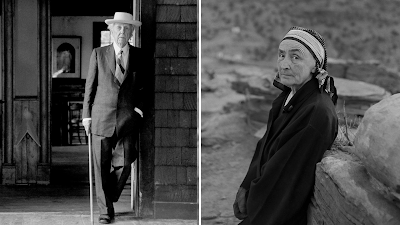October 25, 2023
Images courtesy of Tony Vaccaro Studios/The Monroe Gallery of Photography
Georgia O’Keeffe once wrote, “Nobody sees a flower — really — it is so small it takes time — we haven’t time — and to see takes time, like to have a friend takes time.” Through the lens of O’Keeffe’s life, this notion is evident when considering her nearly three-decades-long friendship with Frank Lloyd Wright.
The two are champions in their field — O’Keeffe’s paintings earned her the title of “Mother of American Modernism,” and Wright is still one of the most celebrated architects in the world — yet, beneath the surface of their achievements lay similarities that run deeper than their success.
Taliesin West’s newest photography exhibition, “American Icons: Wright & O’Keeffe,” explores the pair in a way that’s never been seen before. Running from Oct. 20 through June 3, the exhibit features portraits of the two shot by Tony Vaccaro for “Life Magazine.” The exhibition explores the similarities between Wright and O’Keeffe not just as artists, but as people — and friends.
“They are people that we look very closely at, not just at the artwork they made, but their life,” said Niki Stewart, Taliesin West’s vice president and chief learning and engagement officer. “We as the public don’t always do that with every artist. We sometimes really just focus on their art, but there is a public fascination with both of these figures.”
Both born in rural Wisconsin, Wright and O’Keeffe were drawn to the American Southwest. Wright sought refuge in Arizona during winters, while O’Keeffe found her artistic sanctuary in the heart of New Mexico. The pair were fans of each other’s work, and as Stewart notes, “It’s no overstatement to call them friends.”
One of many similarities was that nature inspired much of their work. O’Keeffe famously painted flowers, landscapes and animal skulls, drawing inspiration from the environment around her. Wright had the same respect for nature, once stating, “No house should ever be on a hill or on anything. It should be of the hill. Belonging to it. Hill and house should live together, each the happier for the other.”
From the 1930s until Wright’s death in 1959, the pair wrote back and forth, sent books, pamphlets and artwork, and shared ideas with each other. Notably, they only met in person once in 1942 at Taliesin, Wright’s Wisconsin home.
“I feel like that’s a story that people can really relate to today with technology,” said Stewart. “We get so close to people who don’t live where we live. We use instant messaging, FaceTime and all these other tools to get close to folks, some of whom we’ve never met.”
In 2021, Taliesin West hosted an exhibit called “Chihuly in the Desert.” The exhibit paired works of glass artist Dale Chihuly with Wright’s architecture. Following the exhibition’s success, Taliesin West knew they wanted to pair Wright’s work with another artist, this time on a smaller, more intimate scale.
Michael A. “Tony” Vaccaro rose to popularity through photos he took while fighting on the front lines of World War II. Vaccaro’s post-military career focused on fashion and celebrity photography for various magazines. Vaccaro would go on to photograph Wright and O’Keeffe, among other celebrities like Sophia Loren, John F. Kennedy and Eartha Kitt. He passed away in 2022, eight days after his 100th birthday.
“After the war, he came home to the United States and started working for magazines like ‘Look’ and ‘Life’ and other magazines that were celebrating what’s good and beautiful about life,” Stewart said. “Because after the war, he decided that’s what he wanted to focus on — what makes life wonderful.”
Visitors of the exhibit can select between an audio or an in-depth guided tour. The audio tour offers a unique experience by featuring recordings of Wright himself, accompanied by some of his favorite music. The in-depth guided tour provides visitors with a more interactive experience, allowing them to engage directly with tour guides who can offer deeper insights and answer questions about the exhibit and its subjects.
“I hope visitors walk out feeling interested in connecting with others and being with other people and being inspired by the people in their lives,” Stewart said. “I think we all run into people who inspire us every day, but what we do with that is up to us. So I hope this inspires you to get connected with others and do great things together.”
The exhibition is included in paid tour admission. To learn more, visit franklloydwright.org.

No comments:
Post a Comment